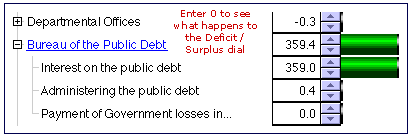Introduction · Activities · Outcome
Intro · Question · Rubric · Background · QuickQuest · Roles · Group · Conclusion · Help · Dictionary
Note: Do you want to do the full WebQuest or this shorter QuickQuest?
See the Help / Teacher's Guide for details.
Introduction
Want to freak out your parents? Tonight when they ask you what you did in school today, you can say, "Aw, you know the usual: hung out with my friends, watched some kid barf up his lunch after running the half mile in PE... oh, and in third period we balanced the national budget." Here's your chance. As a team you have to answer the main questions to this WebQuest:
What's so big about a $5 trillion dollar debt? You may have ideas about dollars and sense from the Money Matters? Subject Sampler and you've probably learned a few things in the last Background phase. Why not try your hand at tweaking the Federal Budget and giving your congressional representatives the benefit of your deep thinking?
Introduction · Activities · Outcome
Learning Activities
#1 - Finding your Group Decision
Use the Hotlist of Links to answer the following questions:
- Is having a $5 trillion national debt a problem? Why or why not?
- What should your U.S. government representatives do about this situation?
The trick here is not to let one person on your team run the show. Everyone has ideas and needs to be heard. Use quotations, facts, numbers, examples, etc., from the links to argue and back up your points. If someone's spouting off steam with no evidence, tell him or her, "Hey, pull your weight and do your homework, why don't ya?" Why? Because in a little while, you'll get the amazing opportunity to put your opinions into a persuasive essay that you'll actually send to your U.S. senators. And you thought this might not be fun...
#2 - An "interesting" experiment
Go to the Budget Explorer. This site is a java applet that lets you change the amounts allocated to U.S. federal government departments and programs. Because it's a java applet, you must have java enabled on your browser. This is a cool app so we hope your browser is capable of using it. Note: actually loading a java applet takes some time so if you're working in a lab or on a slow connection, you might want to do this in advance. Step-by-step InstructionsThe first activity is to actually allocate the federal budget. You'll answer the question: Where Does Your Money Go? You can do this one of two ways. You can check your knowledge of how money is spent or you can change the percentages according to how you believe they should be allocated. In other words, tell it like it is or change it to what you want it to be. Choose the one that best suits your learning goals. Either way, you'll follow the same procedures:
- Use the pulldown menus to select the percentage that you believe or want to be allocated to each category.
- When you've finished making changes, click on the link:
- The Budget Explorer will then give you feedback on how you carved up the budget pie. If you were testing how well you knew the real allocations, see how you closely you got. If you were choosing percentages based on what you wanted the amounts to be, use the feedback to see what areas of the budget you'll be trying to increase or decrease when it's your turn to adjust the actual budget amounts. After you've digested (or printed or saved) the feedback, click on the next link:

|
 |
What amount is set aside for interest? What is interest?
What is the unit? dollars? thousands of dollars, millions? billions, trillions?
What benefit do you think Americans get from this large expenditure?
|  |
How do you suppose everyone in America would come up with twenty grand to reduce the interest to zero? Would doing this help or hurt the economy?
#3 - The Balancing Act
Let's leave the land of fairy tales and work with some real numbers.
- As a team, look through the departments and programs that receive funding from the federal government. Notice that each of the blue links goes directly to the Web site for that Federal department or program. Depending on your time and interest, dig deeper into what some of the more costly or obscure areas are. This could take a minute to a week depending on what your group knows about U.S. government agencies and what you want to find out.
- Discuss with your group members how you think the U.S. government should slice the budget money pie. Remember that compromise and give-and-take are a part of working together. This activity shouldn't create a war, but generate a good discussion and a shared vision. You might look for huge expenditures and trim them or find smaller programs to get rid of entirely. Decide, by agency name, which expenditures you will trim. List these. Are there areas that should receive more funding? List these.
- See what happens to the budget if you start to increase and decrease areas based upon what your team feels is important.
- Keep at it until you either reach a balanced budget, reduce the deficit, or increase funding to areas that you think will increase the country's wealth (Gross Domestic Product).
 When you've achieved a set of allocations that your team believes in, click the link labeled "Next: Results of your changes." If this is the way your group believes the world of the U.S. Federal Budget should be, you can save your results by choosing "File: Save
As...". A nice thing is to save the file as HTML source so you can get the pie charts displayed.
When you've achieved a set of allocations that your team believes in, click the link labeled "Next: Results of your changes." If this is the way your group believes the world of the U.S. Federal Budget should be, you can save your results by choosing "File: Save
As...". A nice thing is to save the file as HTML source so you can get the pie charts displayed.
- Use your results or at least your strategy as the heart of your persuasive argument to your lawmakers.
Introduction · Activities · Outcome
Outcome
It's time to put your opinions, fresh ideas, and evidence into a persuasive essay. You can go about this anyway you see fit. For some of you, you'll understand this task and be on your way brainstorming, drafting, researching, getting feedback, revising, etc. Others who aren't so experienced writing persuasive essays may want a little more support and scaffolding. If this is the case, we've put together a little javascript to help you quickly format a persuasive thesis statement and the barebones of a traditional five paragraph essay outline. If you're interested, try the Thesis Maker. If you know what to do on your own or with someone's help, go for it.
If you and team are writing the essay, make it part of the job that everyone must contribute. Each person might write a body paragraph (with researched evidence) or maybe each person writes their own essay, then everyone helps edit. You can decide.
Once you have a well-researched and communicated essay that's interesting to read, send it into the real world. Use one of the links below (or another approach) to make contact. Take the course of action that you think will be most effective.
- Contacting Congress
- background and contact information on congressional representatives
- All Politics Congress and Governor Guide
- contact information and Web site links
- Contact information for U.S. Senators
- access to official Web pages and email addresses
- Mr. Smith Goes to Washington
- a tool for emailing your essay to many people at once
|
Created May, 1996. Last revised February, 2005 Created by Tom March, Applications Design Team/Wired Learning |

